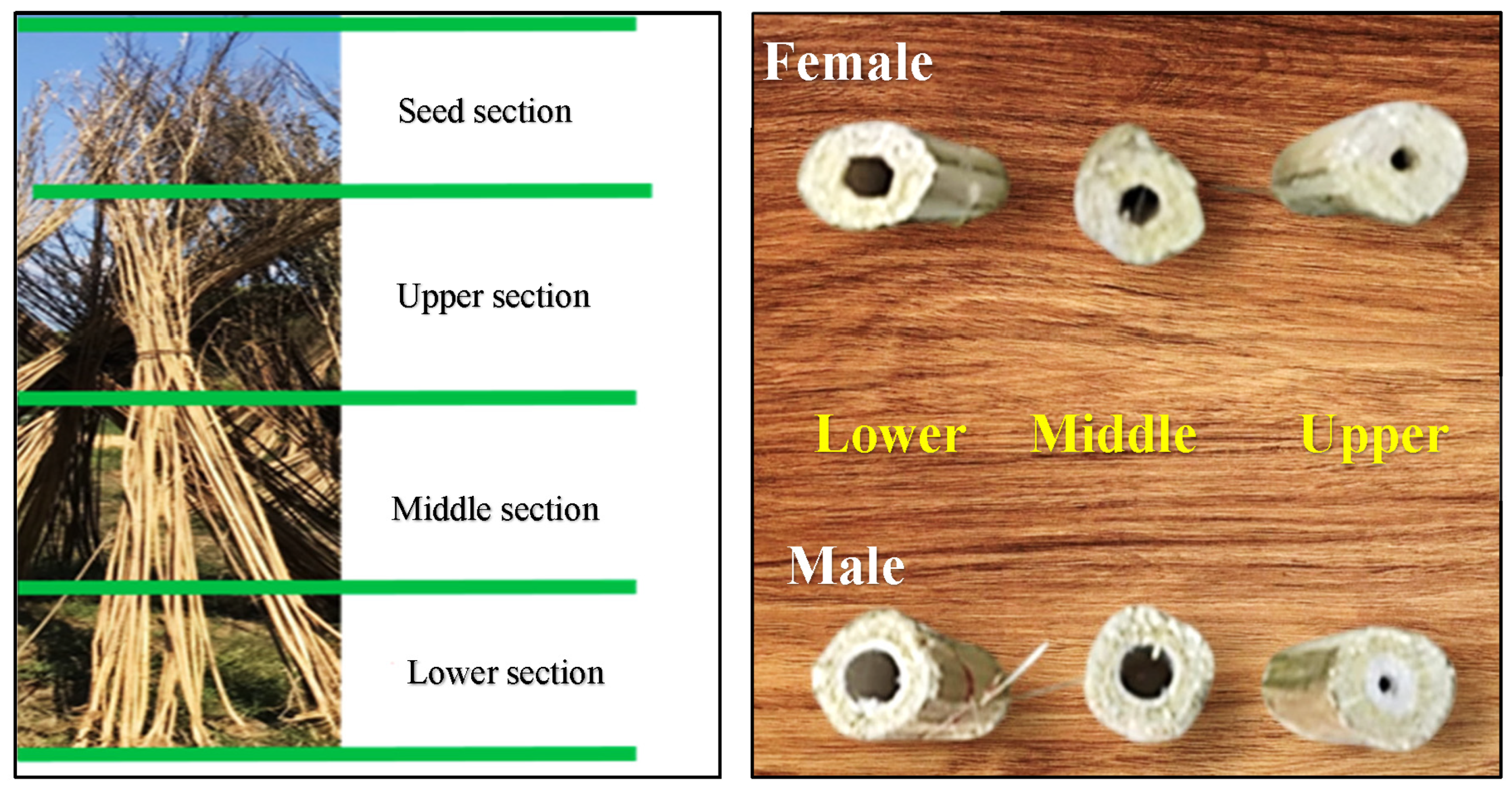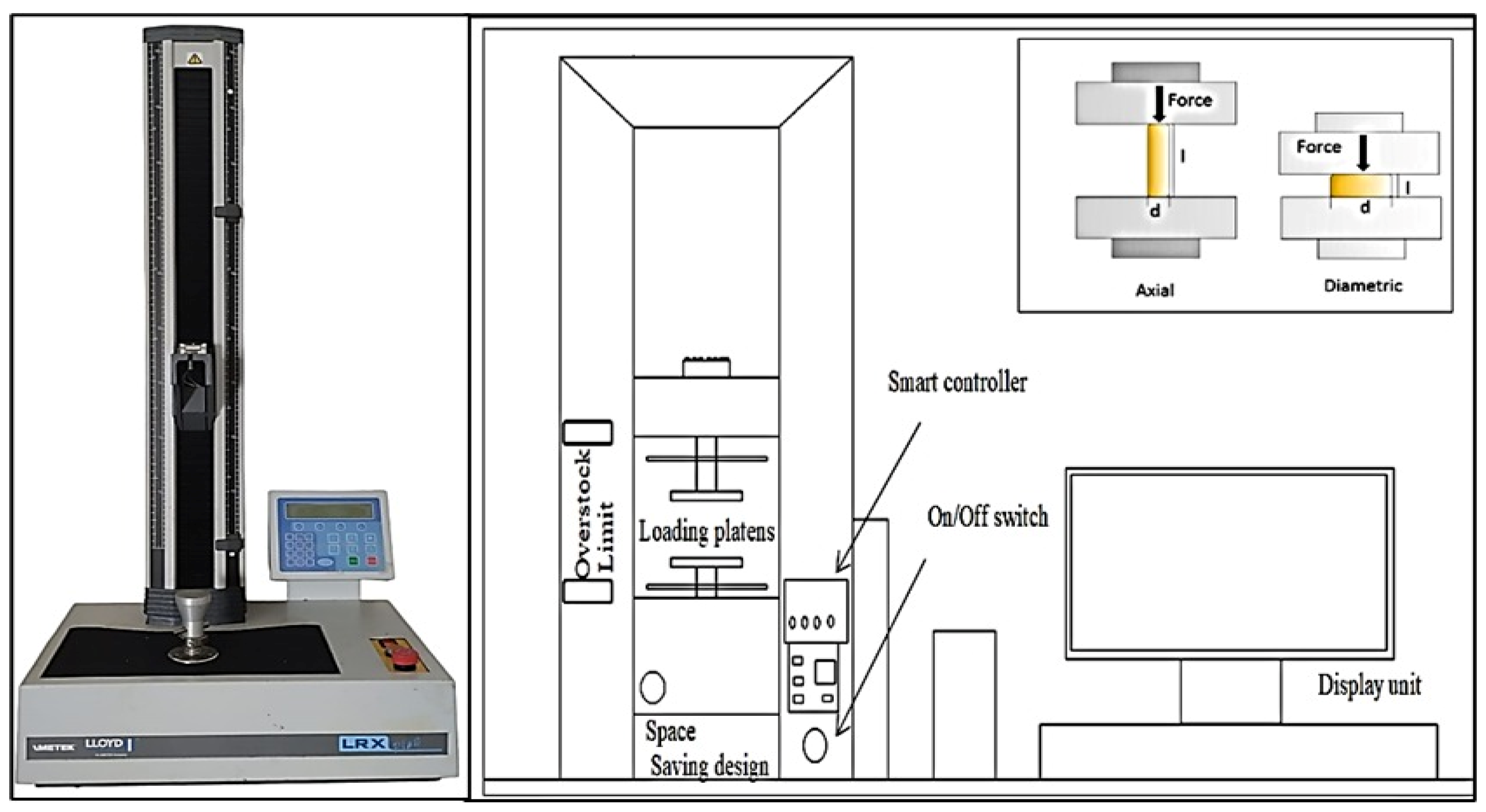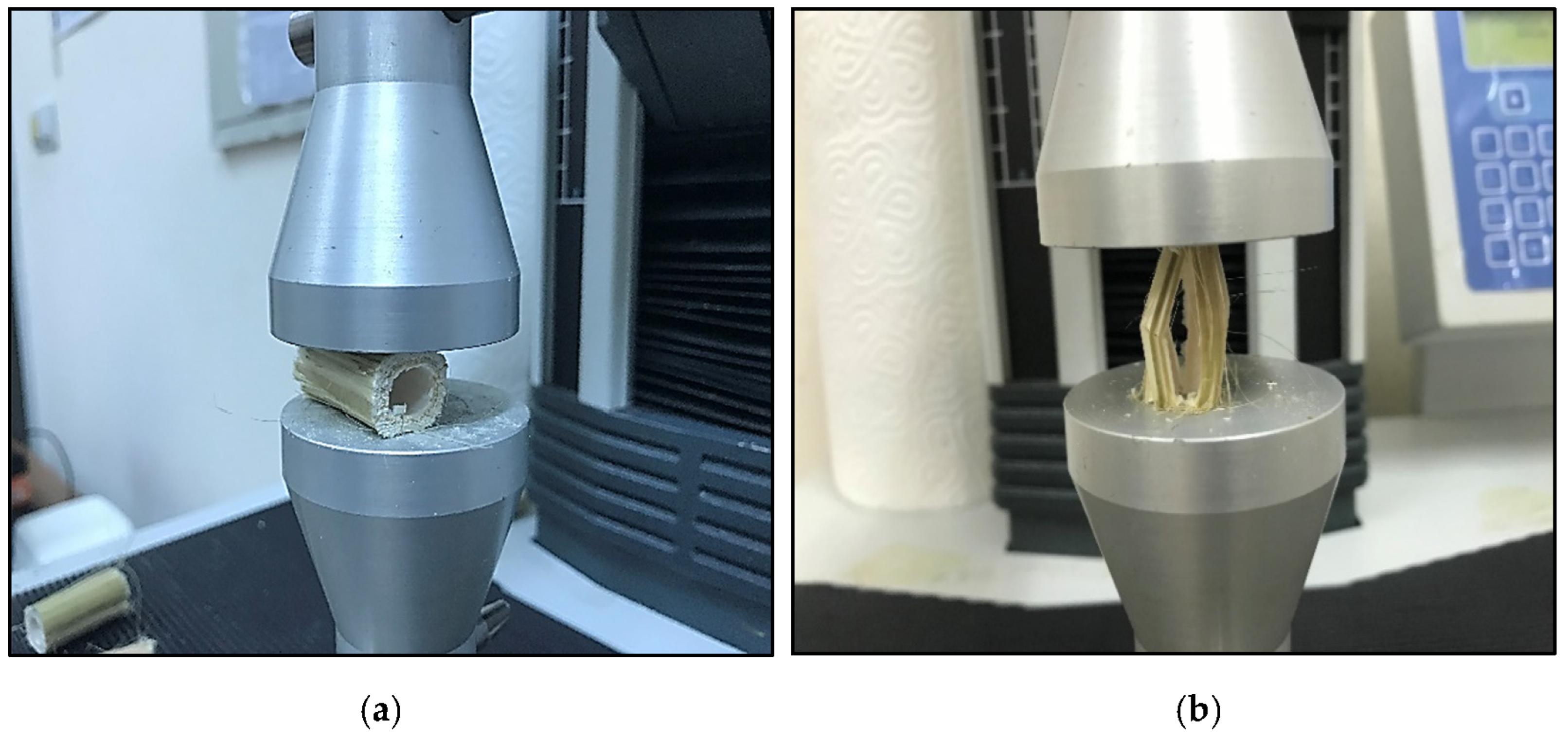Physico-Mechanical Properties of Male and Female Hemp Plants
Abstract
1. Introduction
2. Materials and Methods
2.1. Determination of Physical Properties
2.1.1. Measurement and Calculations
Stalk Diameter
Stalk Length
2.2. Mechanical Properties of Hemp Stalk
2.2.1. Measurement of the Forces
2.2.2. Measurement of the Stress
2.3. Compression Experiment Design
2.4. Statistical Analysis
3. Results
3.1. Physical Properties of Hemp Stalks
3.2. Mechanical Properties of Hemp Stalks
3.2.1. Determination of the Forces
3.2.2. The Compression Stress
4. Discussion
5. Conclusions
Funding
Data Availability Statement
Conflicts of Interest
References
- Trono, D. Elicitation as a tool to improve the accumulation of secondary metabolites in Cannabis sativa. Phytochem. Rev. 2024, 17, 1–37. [Google Scholar] [CrossRef]
- Kaya, S.; Oner, E. Kenevir liflerinin eldesi, karakteristik özellikleri ve tekstil endüstrisindeki uygulamaları. Mehmet Akif Ersoy Üniversitesi Fen Bilim. Enstitüsü Derg. 2020, 11, 108–123. [Google Scholar] [CrossRef]
- Rosso, E.; Armone, R.; Costale, A.; Meineri, G.; Chiofalo, B. Hemp seed (Cannabis sativa L.) varieties: Lipids profile and antioxidant capacity for monogastric nutrition. Animals 2024, 14, 2699. [Google Scholar] [CrossRef] [PubMed]
- Srisuk, S.; Intarat, T.; Damkham, N.; Pisitsak, P. Comparison of infrared-, ultrasonic-, and microwave-assisted mordanting methods for the natural dyeing properties of hemp fabrics. Fibers Polym. 2024, 25, 4349–4360. [Google Scholar] [CrossRef]
- Chaowana, P.; Hnoocham, W.; Chaiprapat, S.; Yimlamai, P.; Chitbanyong, K.; Wanitpinyo, K.; Chaisan, T.; Paopun, Y.; Pisutpiched, S.; Khantayanuwong, S.; et al. Utilization of hemp stalk as a potential resource for bioenergy. Mater. Sci. Energy Technol. 2024, 7, 19–28. [Google Scholar] [CrossRef]
- Yimlamai, P.; Chitbanyong, K.; Wanitpinyo, K.; Puangsin, B.; Nanta, K.; Khantayanuwong, S.; Pisutpiched, S.; Chaisan, T.; Fei, B.; Hiziroglu, S. Properties of mixture of hemp bast and softwood pulp for filter paper manufacture. Heliyon 2024, 10, 3. [Google Scholar] [CrossRef]
- Ahsan, S.M.; Injamum-Ul-Hoque, M.; Shaffique, S.; Ayoobi, A.; Rahman, M.A.; Rahman, M.M.; Choi, H.W. Illuminating Cannabis sativa L.: The Power of Light in Enhancing C. sativa Growth and Secondary Metabolite Production. Plants 2024, 13, 2774. [Google Scholar] [CrossRef]
- Chen, Y.; Sadek, M.A.; Guzman, L.; Lague, C.; Landry, H. Simulation of tensile tests of hemp fibre using discrete element method. Agric. Eng. Int. CIGR J. 2014, 16, 126–135. [Google Scholar]
- Kurtuldu, E.; İşmal, Ö.E. Sürdürülebilir tekstil üretim ve tasarımında yeniden değer kazanan lif: Kenevir. Art-e Sanat Derg. 2019, 1, 12–24. [Google Scholar]
- Kaur, G.; Kander, R. The sustainability of industrial hemp: A literature review of its economic, environmental, and social sustainability. Sustainability 2023, 15, 6457. [Google Scholar] [CrossRef]
- Yano, H.; Fu, W. Hemp: A sustainable plant with high industrial value in food processing. Foods 2023, 12, 651. [Google Scholar] [CrossRef] [PubMed]
- Tănase Apetroaei, V.; Pricop, E.M.; Istrati, D.I.; Vizireanu, C. Hemp Seeds (Cannabis sativa L.) as a Valuable Source of Natural Ingredients for Functional Foods—A Review. Molecules 2024, 29, 2097. [Google Scholar] [CrossRef] [PubMed]
- Kumar, I.M.; Mazhar, M.S.; Nawaz, S. Potential of Establishing Industrial Hemp Value Chains in Northern Australia. Electron. J. Struct. Eng. 2024, 29, 17–22. [Google Scholar]
- Hua, K.Q.; Yi, S.Z.; Sheng, Q.C.; Fu, W.Y.; Xuan, Z.; Xia, S.X.; Yan, C.X.; Dan, Y.D.; Dong, J.W.; Mei, Y.H.; et al. The Study Progress on Breeding of Flax and Industrial Hemp in China. J. Nat. Fibers 2024, 21, 2389159. [Google Scholar]
- Shah, N.; Mwando, E.; Skewes, M.A.; Stanley, S.; Hartley, N. Industrial Hemp Variety Trials: Results from the Northern Territory. In Proceedings of the Agronomy Australia Conference, Albany, Australia, 21–24 October 2024; Available online: https://agronomyconference.com (accessed on 12 January 2025).
- Tsaliki, E.; Kalivas, A. Hemp Crop Opportunities. Ann. Agric. Crop Sci. 2024, 9, 1154. [Google Scholar]
- Di Candilo, M.; Rannalli, P.; Diozzi, M. Investigation of cultivation methods for the mechanization of hemp seed harvest. Adv. Hortic. Sci. 2003, 1, 3–8. [Google Scholar]
- Jicheng, H.; Cheng, S.; Xianwang, L.; Kunpeng, T.; Qiaomin, C.; Bin, Z. Design and Tests of Hemp Harvester. Int. Agric. Eng. J. 2017, 26, 117–127. [Google Scholar]
- Shen, C.; Liang, S.M.; Liang, J.H.; Liu, H.L.; Huang, J.C.; Tian, K.P.; Zhang, B.; Yin, G.D. Status of hemp field production mechanization and research thoughts for China’s hemp production areas. Int. Agric. Eng. J. 2020, 29, 194–204. [Google Scholar]
- Mariz, J.; Guise, C.; Silva, T.L.; Rodrigues, L.; Silva, C.J. Hemp: From Field to Fiber—A Review. Textiles 2024, 4, 165–182. [Google Scholar] [CrossRef]
- Zhou, Y.; Shen, C.; Li, X.W.; Zhang, B.; Huang, J.C.; Tian, K.P. Design and test of 4LMD-160 hemp harvester. Appl. Mech. Mater. 2016, 15, 389–395. [Google Scholar]
- Shen, C.; Bin, Z.; Xianwang, L.; Guodong, Y.; Qiamin, C.; Chunhua, X. Bench cutting tests and analysis for harvesting hemp stalk. Int. J. Agric. Biol. Eng. 2017, 10, 56–67. [Google Scholar]
- Assirelli, A.; Dal Re, L.; Esposito, S.; Cocchi, A.; Santangelo, E. The mechanical harvesting of hemp using in-field stand-retting: A simpler approach converted to the production of fibers for industrial use. Sustainability 2020, 12, 8795. [Google Scholar] [CrossRef]
- Tilkat, E.; Hoşer, A.; Tilkat, E.A.; Süzerer, V.; Çiftçi, Y.Ö. Production of Industrial Hemp: Breeding Strategies, Limitations, Economic Expectations, and Potential Applications. Türk Bilimsel Derlemeler Derg. 2023, 16, 54–74. [Google Scholar]
- Sîrbu, F.D.; Dumitru, I.; Iuga, D.E.; Voicea, I.; Vlăduţ, N.V.; Oprescu, R.M. Considerations regarding the hemp harvesting. Acta Tech. Corviniensis Bull. Eng. 2019, 12, 97–100. [Google Scholar]
- Tian, K.; Li, X.; Shen, C.; Zhang, B.; Huang, J.; Wang, J.; Zhou, Y. Design and test of cutting blade of cannabis harvester based on longicorn bionic principle. Trans. Chin. Soc. Agric. Eng. 2017, 33, 56–61. [Google Scholar]
- Trociński, A.; Wieruszewski, M.; Bartkowiak, M.; Dziurka, D.; Mirski, R. The Influence of Hemp Fibers (Cannabis sativa L.) on the Mechanical Properties of Fiber–Gypsum Boards Reinforcing the Gypsum Matrix. Polymers 2024, 16, 2644. [Google Scholar] [CrossRef]
- Zhou, Y.; Li, X.; Shen, C.; Tian, K.; Zhang, B.; Huang, J. Experimental analysis on mechanical model of industrial hemp stalk. Trans. Chin. Soc. Agric. Eng. 2016, 32, 22–29. [Google Scholar]
- Decker, A.; Drean, J.Y.; Sarazin, V.; Harzallah, O. Influence of Different Retting on Hemp Stem and Fiber Characteristics Under the East of France Climate Conditions. J. Nat. Fibers 2024, 21, 2350621. [Google Scholar] [CrossRef]
- Leblicq, T.; Vanmaercke, S.; Ramon, H.; Saeys, W. Mechanical analysis of the bending behaviour of plant stems. Biosyst. Eng. 2015, 1, 87–99. [Google Scholar]
- Khan, M.M.; Chen, Y.; Laguë, C.; Landry, H.; Peng, Q.; Zhong, W. Compressive properties of Hemp (Cannabis sativa L.) stalks. Biosyst. Eng. 2010, 106, 315–323. [Google Scholar]
- Ahangarnezhad, N.; Najafi, G.; Jahanbakhshi, A. Determination of the physical and mechanical properties of a potato (the Agria variety) in order to mechanise the harvesting and post-harvesting operations. Res. Agric. Eng. 2019, 65, 33–39. [Google Scholar]
- Galedar, M.N.; Jafari, A.; Mohtasebi, S.S.; Tabatabaeefar, A.; Sharifi, A.; O’dogherty, M.J.; Rafiee, S.; Richard, G. Effects of moisture content and level in the crop on the engineering properties of alfalfa stems. Biosyst. Eng. 2008, 101, 199–208. [Google Scholar]
- Oke, B.O.; Kaul, R.N.; Mittal, J.P. Physical and mechanical properties of sorghum (Sorghum bicolor) stalk harvested at various intervals after grain maturity. Agric. Wastes 1984, 11, 31–45. [Google Scholar]
- Bhaholyotin, B.; Kradangna, P.; Ichito, K.; Goto, Y. Study on some physical properties of sugar cane for whole stalk harvester design. Agric. Nat. Resour. 1988, 22, 88–90. [Google Scholar]
- Assirelli, A.; Santangelo, E.; Stagno, F.; Roccuzzo, G.; Musio, S.; Amaducci, S. Hemp Sowing Seed Production: Assessment of New Approaches in North-Italy. Sustainability 2022, 14, 17020. [Google Scholar]
- Kumeroa, F.; Komahan, S.; Sofkova-Bobcheva, S.; Clavijo McCormick, A. Characterization of the volatile profiles of six industrial hemp (Cannabis sativa L.) cultivars. Agronomy 2022, 12, 2651. [Google Scholar] [CrossRef]
- Leme, F.M.; Schönenberger, J.; Staedler, Y.M.; Teixeira, S.P. Comparative floral development reveals novel aspects of structure and diversity of flowers in Cannabaceae. Bot. J. Linn. Soc. 2020, 193, 64–83. [Google Scholar]
- Shi, J.; Schilling, S.; Melzer, R. Morphological and genetic analysis of inflorescence and flower development in hemp (Cannabis sativa L.). bioRxiv 2024. [Google Scholar] [CrossRef]
- Spitzer-Rimon, B.; Duchin, S.; Bernstein, N.; Kamenetsky, R. Architecture and florogenesis in female Cannabis sativa plants. Front. Plant Sci. 2019, 2, 350. [Google Scholar]
- Shi, J.; Toscani, M.; Dowling, C.A.; Schilling, S.; Melzer, R. Identification of genes associated with sex expression and sex determination in hemp (Cannabis sativa L.). J. Exp. Bot. 2025, 76, 175–190. [Google Scholar]
- Bafort, F.; Libault, A.; Maron, E.; Kohnen, S.; Ancion, N.; Jijakli, M.H. Operational Costs and Analysis of Agronomic Characteristics on Cannabidiol and Cannabigerol Hemp (Cannabis sativa L.) in Hydroponic Soilless Greenhouse and Field Cultivation. Horticulturae 2024, 10, 1271. [Google Scholar] [CrossRef]
- El Bakali, I.; Hassoun, M.; Boutahar, A.; El Bakali, S.; Sakar, E.H.; Kadiri, M.; Merzouki, A. A comparative evaluation of biomass and resin by-products attributes of six hemp (Cannabis sativa L.) cultivars grown in Rif Mountains (northern Morocco). Vegetos 2024, 14, 1–3. [Google Scholar]
- Spano, M.; Di Matteo, G.; Ingallina, C.; Sobolev, A.P.; Giusti, A.M.; Vinci, G.; Cammarone, S.; Tortora, C.; Lamelza, L.; Prencipe, S.A.; et al. Industrial hemp (Cannabis sativa L.) inflorescences as novel food: The effect of different agronomical practices on chemical profile. Foods 2022, 11, 3658. [Google Scholar] [CrossRef]
- Barbosa-Xavier, K.; Pedrosa-Silva, F.; Almeida-Silva, F.; Venancio, T.M. Cannabis Expression Atlas: A comprehensive resource for integrative analysis of Cannabis sativa L. gene expression. Physiol. Plant. 2024, 176, 70010. [Google Scholar]
- Cerri, M.; Reale, L.; Roscini, F.; Fornaciari da Passano, M.; Orlandi, F. Fibers development in a dioecious hemp cultivar: The role of plant sex and cultivation conditions. Plant Biosyst. Int. J. Deal. All Asp. Plant Biol. 2023, 157, 140–146. [Google Scholar]
- Campbell, L.G.; Peach, K.; Wizenberg, S.B. Dioecious hemp (Cannabis sativa L.) plants do not express significant sexually dimorphic morphology in the seedling stage. Sci. Rep. 2021, 11, 16825. [Google Scholar]
- Li, X.; Du, G.; Wang, S.; Meng, Y. Influence of Gender on the Mechanical and Physical Properties of Hemp Shiv Fiber Cell Wall in Dioecious Hemp Plant. Bioresources 2015, 1, 10. [Google Scholar]
- Feng, C.; Liu, C.; Wang, B.; Shi, H.; Sun, H.; Li, Y.; Hu, J. Research on the Operational Parameters and Performance of Key Components of an Industrial Hemp Harvester and Drier. Agriculture 2025, 15, 141. [Google Scholar] [CrossRef]
- Holotiuk, M.V.; Shymko, A.V.; Puts, V.S.; Martyniuk, V.L. Machine for spring technological harvesting of industrial hemp. Inmateh-Agric. Eng. 2024, 74, 3. [Google Scholar]
- Mazian, B.; Bergeret, A.; Benezet, J.C.; Malhautier, L. Influence of field retting duration on the biochemical, microstructural, thermal and mechanical properties of hemp fibres harvested at the beginning of flowering. Ind. Crops Prod. 2018, 116, 170–181. [Google Scholar]
- Squires, C.A.; Netting, K.H.; Chambers, A.R. Understanding the factors affecting the compressive testing of unidirectional carbon fibre composites. Compos. Part B Eng. 2007, 38, 481–487. [Google Scholar]
- ASTM Standards D695-08; Standard Test Method for Compressive Properties of Rigid Plastics. ASTM International: West Conshohocken, PA, USA, 2008.
- Abdelhady, A.; Ibrahim, M.; Mansour, H.; El-Shafie, A.; Abd El Rahman, E. Physico-mechanical properties of sugarcane stalks. Acta Technol. Agric. 2023, 26, 142–151. [Google Scholar]
- Van Dillewijn, C. Botany of Sugarcane; Chronica Botanica: Waltham, MA, USA, 1952; p. 371. [Google Scholar]
- Aydın, İ.; Arslan, S.J. Mechanical properties of cotton shoots for topping. Ind. Crops Prod. 2018, 112, 396–401. [Google Scholar]
- Scutaru, M.L.; Cofaru, C.; Drăghicescu, H.T. Research on Study Hemp Fiber Subjected to Three Point Bend Tests. In Proceedings of the 4th International Conference Advanced Composite Materials Engineering COMAT 2012, Brasov, Romania, 18–20 October 2012. [Google Scholar]
- Hemmatian, R.; Najafi, G.; Hosseinzadeh, B.; Tavakoli, H.T.; Khoshtaghaza, M.H. Experimental and Theoretical Investigation of the Effects of Moisture Content and Internodes Position on Shearing Characteristics of Sugar Cane Stems. J. Agric. Sci. Technol. 2012, 14, 963–974. [Google Scholar]
- Huang, J.; Shen, C.; Ji, A.; Tian, K.; Zhang, B.; Li, X.; Chen, Q. Design and test of two-wheeled walking hemp harvester. Int. J. Agric. Biol. Eng. 2020, 13, 127–137. [Google Scholar]
- Esehaghbeygi, A.; Hoseinzadeh, B.; Khazaei, M.; Masoumi, A. Bending and shearing properties of wheat stem of alvand variety. World Appl. Sci. J. 2009, 6, 1028–1032. [Google Scholar]
- Li, X.; Wang, S.; Du, G.; Wu, Z.; Meng, Y. Variation in physical and mechanical properties of hemp stalk fibers along height of stem. Ind. Crops Prod. 2013, 42, 344–348. [Google Scholar]
- İnce, A.H.; Uğurluay, S.; Güzel, E.; Özcan, M.T. Bending and shearing characteristics of sunflower stalk residue. Biosyst. Eng. 2005, 92, 175–181. [Google Scholar]
- Lo, T.Y.; Cui, H.Z.; Leung, H.C. The effect of fiber density on strength capacity of bamboo. Mater. Lett. 2004, 58, 2595–2598. [Google Scholar]
- Chen, Y.; Chen, J.; Zhang, Y.; Zhou, D. Effect of harvest date on shearing force of maize stems. Livest. Sci. 2007, 111, 33–44. [Google Scholar]
- Boydaş, M.G.; Comakli, M.; Sayinci, B.; Kara, M. Effects of moisture content, internode region, and oblique angle on the mechanical properties of sainfoin stem. Turk. J. Agric. For. 2019, 43, 254–263. [Google Scholar] [CrossRef]
- Chen, Y.; Gratton, J.L.; Liu, J. Power requirements of hemp cutting and conditioning. Biosyst. Eng. 2004, 87, 417–424. [Google Scholar] [CrossRef]
- Tavakoli, H.; Mohtasebi, S.S.; Jafari, A. Effect of Moisture Content and Loading Rate on the Shearing Characteristics of Barley Straw by Internode Position. Agric. Eng. Int. CIGR J. Manuscr. 2009, 55, 1176. [Google Scholar]
- Galedar, M.N.; Tabatabaeefar, A.; Jafari, A.; Sharifi, A.; Rafiee, S. Bending and shearing characteristics of alfalfa stems. Agric. Eng. Int. CIGR J. 2008, 2008, 1–9. [Google Scholar]
- O’dogherty, M.J.; Huber, J.A.; Dyson, J.; Marshall, C.J. A study of the physical and mechanical properties of wheat straw. J. Agric. Eng. Res. 1995, 62, 133–142. [Google Scholar] [CrossRef]
- Halyk, R.M. Tensile and Shear Strength Characteristics of Alfalfa Stems. Master’s Thesis, University of Nebraska, Lincoln, NE, USA, 1962. [Google Scholar]




| Sources of Variation | Parameters | ||
|---|---|---|---|
| Thickness (mm) | Inner Diameter (mm) | Outer Diameter (mm) | |
| Sex | |||
| Male | 2.628 ± 0.71 a | 4.452 ± 1.26 a | 9.708 ± 2.20 a |
| Female | 2.347 ± 0.71 b | 3.986 ± 1.36 b | 8.681 ± 2.23 b |
| Direction | |||
| Axial | 2.562 ± 0.67 a | 4.162 | 9.286 |
| Lateral | 2.413 ± 0.76 b | 4.277 | 9.104 |
| Section | |||
| Lower | 3.149 ± 0.67 a | 4.915 ± 1.05 a | 11.142 ± 1.71 a |
| Middle | 2.335 ± 0.50 b | 4.843 ± 0.95 a | 9.585 ± 1.27 b |
| Upper | 1.978 ± 0.39 c | 2.901 ± 0.83 b | 6.857 ± 1.24 c |
| LSD | |||
| Sex | 0.0334 * | 0.0648 * | 0.0829 * |
| Direction | 0.0334 * | n.s | n.s |
| Section | 0.0409 * | 0.0794 * | 0.1016 * |
| CV (%) | 0.1779 | 0.2035 | 0.1195 |
| Sources of Variation | Parameters | ||
|---|---|---|---|
| Load (N) | Distance (mm) | Energy (J) | |
| Sex | |||
| Male | 877.396 a | 1.888 a | 1.403 a |
| Female | 670.390 b | 1.781 b | 1.068 b |
| Direction | |||
| Axial | 1436.091 a | 2.949 a | 2.423 a |
| Lateral | 111.695 b | 0.719 b | 0.048 b |
| Section | |||
| Lower | 1025.566 a | 2.024 a | 1.634 a |
| Middle | 765.345 b | 1.853 a | 1.261 b |
| Upper | 530.768 c | 1.627 b | 0.812 c |
| Sex × Direction | |||
| Male–Axial | 1627.584 a | 3.091 a | 2.762 a |
| Female–Axial | 1244.598 b | 2.808 b | 2.085 b |
| Male–Lateral | 127.208 c | 0.685 c | 0.044 c |
| Female–Lateral | 96.182 c | 0.754 c | 0.052 c |
| Direction × Section | |||
| Axial–Lower | 1911.262 a | 3.119 | 3.190 a |
| Axial–Middle | 1434.081 b | 3.010 | 2.482 b |
| Axial–Upper | 962.932 c | 2.718 | 1.597 c |
| Lateral–Lower | 139.870 d | 0.930 | 0.078 c |
| Lateral–Middle | 98.605 d | 0.695 | 0.039 c |
| Lateral–Upper | 96.611 d | 0.536 | 0.027 c |
| LSD | |||
| Sex | 21.9215 * | 0.0270 * | 0.0444 * |
| Direction | 21.9215 * | 0.0270 * | 0.0444 * |
| Section | 26.8482 * | 0.0331 * | 0.0543 * |
| Sex-Direction | 31.0016 * | 0.0382 * | 0.0627 * |
| Direction–Section | 37.9691 * | n.s | 0.0769 * |
| CV (%) | 0.3754 | 0.1951 | 0.4759 |
Disclaimer/Publisher’s Note: The statements, opinions and data contained in all publications are solely those of the individual author(s) and contributor(s) and not of MDPI and/or the editor(s). MDPI and/or the editor(s) disclaim responsibility for any injury to people or property resulting from any ideas, methods, instructions or products referred to in the content. |
© 2025 by the author. Licensee MDPI, Basel, Switzerland. This article is an open access article distributed under the terms and conditions of the Creative Commons Attribution (CC BY) license (https://creativecommons.org/licenses/by/4.0/).
Share and Cite
Duran, H. Physico-Mechanical Properties of Male and Female Hemp Plants. Agriculture 2025, 15, 776. https://doi.org/10.3390/agriculture15070776
Duran H. Physico-Mechanical Properties of Male and Female Hemp Plants. Agriculture. 2025; 15(7):776. https://doi.org/10.3390/agriculture15070776
Chicago/Turabian StyleDuran, Hüseyin. 2025. "Physico-Mechanical Properties of Male and Female Hemp Plants" Agriculture 15, no. 7: 776. https://doi.org/10.3390/agriculture15070776
APA StyleDuran, H. (2025). Physico-Mechanical Properties of Male and Female Hemp Plants. Agriculture, 15(7), 776. https://doi.org/10.3390/agriculture15070776





